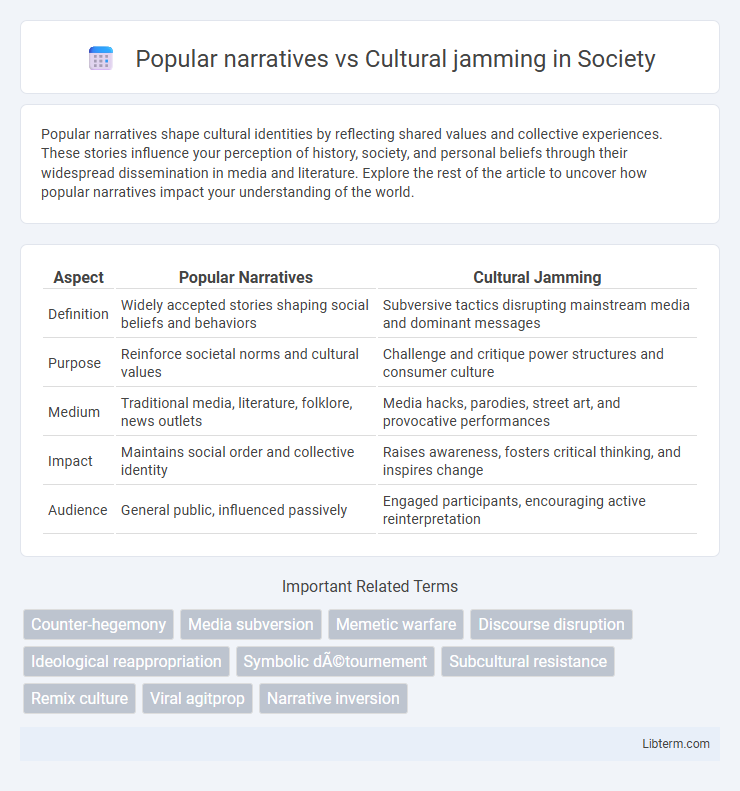Popular narratives shape cultural identities by reflecting shared values and collective experiences. These stories influence your perception of history, society, and personal beliefs through their widespread dissemination in media and literature. Explore the rest of the article to uncover how popular narratives impact your understanding of the world.
Table of Comparison
| Aspect | Popular Narratives | Cultural Jamming |
|---|---|---|
| Definition | Widely accepted stories shaping social beliefs and behaviors | Subversive tactics disrupting mainstream media and dominant messages |
| Purpose | Reinforce societal norms and cultural values | Challenge and critique power structures and consumer culture |
| Medium | Traditional media, literature, folklore, news outlets | Media hacks, parodies, street art, and provocative performances |
| Impact | Maintains social order and collective identity | Raises awareness, fosters critical thinking, and inspires change |
| Audience | General public, influenced passively | Engaged participants, encouraging active reinterpretation |
Understanding Popular Narratives
Understanding popular narratives involves examining the recurring themes and stories that shape societal beliefs and values, often propagated through mass media, literature, and entertainment. These narratives serve as frameworks for interpreting reality, reinforcing dominant ideologies and cultural norms. Analyzing the construction and dissemination of popular narratives reveals how power dynamics influence public perception and identity formation.
What Is Cultural Jamming?
Cultural jamming is a form of protest that disrupts or subverts popular narratives by altering mainstream media messages to expose underlying social or political issues. It uses techniques like parody, satire, and detournement to challenge corporate advertising and mass media, aiming to provoke critical thinking and social change. Unlike traditional narratives that promote dominant ideologies, cultural jamming creates counter-narratives that question consumerism, power structures, and cultural norms.
Historical Roots of Popular Narratives
Popular narratives trace their roots to ancient storytelling traditions, serving to reinforce dominant cultural values and societal norms through repeated themes and archetypes. These narratives often emerge from institutionalized media, literature, and folklore, shaping collective identity and historical memory. In contrast, cultural jamming originates as a countercultural practice during the late 20th century, subverting mainstream messages to challenge power structures embedded within popular narratives.
Origins and Evolution of Cultural Jamming
Cultural jamming originated in the late 20th century as a subversive response to mass media and consumer culture, challenging dominant popular narratives by disrupting advertising and mainstream messages. Rooted in Situationist theories from the 1950s and 60s, it evolved through tactics like detournement to expose and critique societal norms and corporate power. Over time, cultural jamming expanded with digital activism, blending art and protest to resist cultural homogenization and promote alternative perspectives.
Media Influence: Shaping Societal Stories
Popular narratives in media shape societal stories by reinforcing dominant cultural values and ideologies through repeated themes and imagery. Cultural jamming disrupts these mainstream media messages by subverting or parodying popular narratives, challenging audiences to question and reinterpret the underlying assumptions. This tension between popular narratives and cultural jamming highlights the dynamic process through which media influences public perception and social norms.
Cultural Jamming as a Form of Resistance
Cultural jamming operates as a form of resistance by subverting dominant popular narratives and exposing the underlying power structures that shape mainstream media and consumer culture. It challenges corporate and political messaging through satirical, parodic, and disruptive tactics, forcing audiences to reconsider accepted norms and question authority. By reclaiming symbols and messages, cultural jamming empowers marginalized voices and promotes critical awareness of societal manipulation.
Case Studies: Pop Culture vs. Culture Jamming
Popular narratives often reinforce dominant cultural themes through mainstream media, creating predictable storylines that shape societal values. In contrast, culture jamming disrupts these narratives by using parody and subversion to challenge consumerism and political complacency, as seen in case studies like Adbusters' campaigns against advertising saturation. Pop culture's influence on identity and behavior contrasts with culture jamming's role in provoking critical awareness and fostering alternative viewpoints.
Impact on Public Perception
Popular narratives shape public perception by reinforcing dominant ideologies and social norms through mass media and storytelling. Cultural jamming disrupts these narratives by subverting advertisements, symbols, and messages to expose contradictions and promote critical thinking. This contrast influences how audiences interpret information, either passively accepting mainstream views or actively questioning societal constructs.
Challenges and Criticisms of Both Approaches
Popular narratives often face challenges related to oversimplification and reinforcing dominant ideologies, limiting diverse perspectives. Cultural jamming, while effective in disrupting mainstream messages, is criticized for its sometimes ambiguous intent and limited reach beyond niche audiences. Both approaches struggle with sustaining long-term impact and avoiding co-optation by the very systems they critique.
The Future of Narrative Disruption and Engagement
Popular narratives shape societal beliefs through widely accepted stories and media, often reinforcing dominant ideologies. Cultural jamming challenges these narratives by subverting mainstream messages and encouraging critical audience engagement, using tactics like satire, remixing, and guerrilla art. The future of narrative disruption lies in leveraging digital technologies and collaborative platforms to amplify alternative voices and foster interactive, participatory storytelling that destabilizes hegemonic discourse.
Popular narratives Infographic

 libterm.com
libterm.com